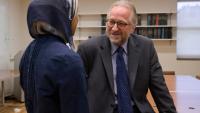Greg Freyer

Associate Professor of Environmental Health Sciences
Freyer studies the cell’s response to environmental agents that damage DNA. His work has identified elements of the complex set of molecular events that help maintain genomic stability following DNA damage. Freyer is also director of Academic Affairs for Environmental Health Sciences and one of the School’s most popular classroom instructors, and a 2015 winner of Columbia’s Teaching Excellence award.
Did you always want to focus on environmental health sciences?
I didn't start out being drawn to this field. I'm a biochemist and molecular biologist by training but moved to Environmental Health in 1994 so it's been 20 years already. My love of science and my desire to do research grew from the idea of problem-solving and trying to understand mechanisms. Still, when I think about what really gets me interested about research, it's not curing diseases or trying to make the world a better place, or even solving the world’s environmental crises—which I think are really important—but what excites me is understanding mechanisms. I'm less interested that BPA causes diseases, and more interested in how BPA causes diseases.
Everyone at the School was thrilled that you won Columbia University’s highest teaching honor this year. What makes you so passionate about teaching?
I always knew I wanted to teach and do interesting scientific research. I went on a very straight trajectory from undergraduate to graduate school, to post-docs, and then onto academic positions. My interest in teaching actually started in graduate school when I began teaching a really boring lab course. To keep students from just going through the motions, I conceived of the idea that you should have lab exercises that build on each other. When I was a postdoc, I developed a whole curriculum to teach molecular biology to local high school students based on that concept. Initially we set out writing a set of lab exercises that we taught on the weekends and in weeklong courses in the summer. Then it evolved into a nationwide curriculum—and a very successful textbook, DNA Science. My belief is that students learn by doing.
What is your favorite part about working with diverse public health students?
On the teaching side, especially in the Core, you sometimes have that eureka moment and realize that students, particularly those without a strong science background, understand a complex public health concept. I love when we are able to relate environmental health to their lives and their future careers in public health. A lot of what Joe Graziano and I teach in the class is not only about public health but science in relation to students’ daily lives. I like the diversity of the public health student body, people with different backgrounds with an interest in public health. I'm also inspired by public health students—especially those doing global and international work—because of their personal sacrifices to advance some greater good.
See more EHS Faculty Spotlights.